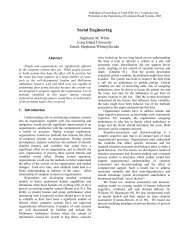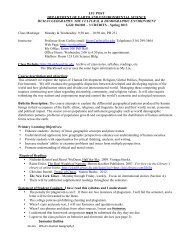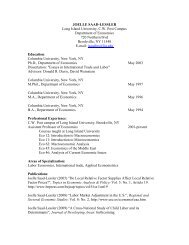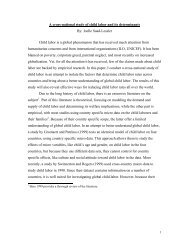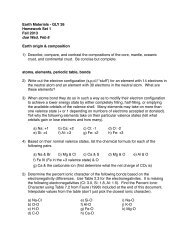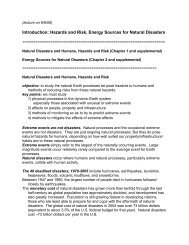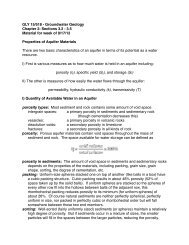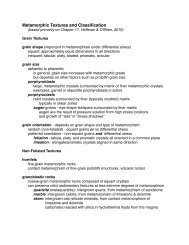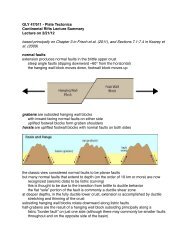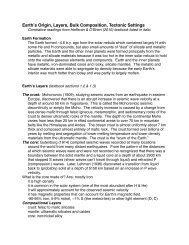Principles of Chemistry (CHM 3, 4) - Myweb @ CW Post - Long ...
Principles of Chemistry (CHM 3, 4) - Myweb @ CW Post - Long ...
Principles of Chemistry (CHM 3, 4) - Myweb @ CW Post - Long ...
You also want an ePaper? Increase the reach of your titles
YUMPU automatically turns print PDFs into web optimized ePapers that Google loves.
LONG ISLAND UNIVERSITY<br />
C.W. POST CAMPUS<br />
<strong>Principles</strong> <strong>of</strong> <strong>Chemistry</strong> (<strong>CHM</strong> 3, 4) Syllabus 2009-2010<br />
Prerequisite: Mathematics 3 Corequisites: Mathematics 7–8<br />
Mandatory TEXT: CHEMISTRY, 10 th ed. By Raymond Chang (ISBN: 978-0-07-727431-6).<br />
A discounted package includes Students Solutions Manual<br />
and is available in Campus bookstore.<br />
Chs.<br />
LECTURE TOPICS – <strong>CHM</strong> 3<br />
1. The scope <strong>of</strong> chemistry. Classification <strong>of</strong> matter and its properties. Measurement <strong>of</strong><br />
Matter. Uncertainties in Scientific Measurements.<br />
2. The Atomic Theory. The Nuclear Atom. Chemical Elements. Introduction to Periodic<br />
Table. The Concept <strong>of</strong> the Mole and The Avogadro Constant.<br />
3. Atomic and Molar Masses. Chemical Compounds and Their Formulas. The Mole<br />
Concept and Chemical Compounds. Composition <strong>of</strong> Chemical Compounds.<br />
4. Chemical Reactions and Chemical Equations. Conservation Laws <strong>of</strong> Elements and<br />
Mass. Stoichiometry. Chemical Reactions in Solutions.<br />
5. The Nature <strong>of</strong> Aqueous Solutions. Classification <strong>of</strong> Reactions in Aqueous Solutions.<br />
Solution Stoichiometry.<br />
6. Gases. The Simple Gas Laws. The Ideal Gas Equation. Ideal Gases Opposed to Real<br />
Gases. Kinetic–Molecular Theory <strong>of</strong> Gases.<br />
7. Thermochemistry. The First Law <strong>of</strong> Thermodynamics. Energy Changes in Chemical<br />
Reactions. Calorimetry. Standard Enthalpies. Hess's Law.<br />
9. Quantum–Mechanical Preliminaries. Electron configuration. The Aufbau Principle.<br />
10. Development <strong>of</strong> the Periodic Table. Periodic Classification <strong>of</strong> the Elements. Periodic<br />
Variation <strong>of</strong> Physical and Chemical Properties.<br />
11. Basic Concepts <strong>of</strong> Chemical Bonding. Lewis Octet Rule. Formal Charge. The Concept<br />
<strong>of</strong> Resonance. The Shapes <strong>of</strong> Molecules.<br />
12. Additional Aspects <strong>of</strong> Bonding. Molecular Geometry: VSEPR Model. Hybridization.<br />
13. Intermolecular Forces and Types <strong>of</strong> Substances. Phase Diagrams. Liquid–Vapor<br />
Equilibrium. Crystal Structure.<br />
LABORATORY TOPICS – <strong>CHM</strong> 3L<br />
Check–in: Introduction to Safety Rules and Safety Behavior in the Lab.<br />
Exp.# 1: Measurements, Precision, Accuracy and Significant Figures.<br />
Exp.# 2: What Is a Chemical Reaction? Chemical and Physical Change.
<strong>Principles</strong> <strong>of</strong> <strong>Chemistry</strong> Syllabus Page 2 <strong>of</strong> 3<br />
Exp.# 3:<br />
Exp.# 4:<br />
Exp.# 5:<br />
Exp.# 6:<br />
Exp.# 7:<br />
Exp.# 8:<br />
Exp.# 9:<br />
Exp.#10:<br />
Exp.#11:<br />
Determination <strong>of</strong> an Empirical Formula.<br />
Acid – Base Titration.<br />
Oxidation – Reduction Titration.<br />
Analysis <strong>of</strong> Some Commercial Bleaches.<br />
The Empirical Gas Laws.<br />
Determination <strong>of</strong> the Universal Gas Constant.<br />
Molar Mass <strong>of</strong> a Volatile Liquid. Modified Dumas Bulb Method.<br />
Thermochemistry I. The Heat <strong>of</strong> Reactions.<br />
Thermochemistry II. The Heat <strong>of</strong> Reactions. The Hess' Law.<br />
LECTURE TOPICS – <strong>CHM</strong> 4<br />
Chs.<br />
14. Colligative Properties <strong>of</strong> Solutions. Concentration Units. Solubility <strong>of</strong> Gases. Vapor<br />
Pressure <strong>of</strong> Solutions. Osmotic Pressure. Freezing–Point Depression and Boiling–<br />
Point Elevation.<br />
15. Chemical Kinetics. The Rate Laws. Activation Energy and Temperature Dependence <strong>of</strong><br />
Rate Constants. Reaction Mechanisms.<br />
16. Dynamic Equilibrium. The Equilibrium Constant Expression. Significance <strong>of</strong><br />
Equilibrium Constant Value. Predicting the Direction <strong>of</strong> a Reaction. Equilibrium<br />
Calculations.<br />
17. Acids and Bases. Br/o nsted–Lowry Theory. Acid–Base Properties <strong>of</strong> Water. The pH–<br />
Scale. Acid–Base Properties <strong>of</strong> Salts.<br />
18. Acid–Base Equilibria. The Common-Ion Effect and Buffers. Acid–Base Indicators.<br />
19. Solubility Equilibria. Complex–Ion Equilibria. <strong>Principles</strong> <strong>of</strong> Qualitative Analysis.<br />
20. Chemical Thermodynamics. Spontaneous Change. The Second Law <strong>of</strong><br />
Thermodynamics. Gibbs Free Energy and Chemical Equilibrium. Thermodynamics in<br />
Living Systems.<br />
21. <strong>Chemistry</strong> <strong>of</strong> Redox Reactions. Spontaneity <strong>of</strong> Redox Reactions. Batteries. Corrosion.<br />
Industrial Applications <strong>of</strong> Electrochemistry: Electrolysis.<br />
LABORATORY TOPICS – <strong>CHM</strong> 4L<br />
Check–in:<br />
Exp.# 1:<br />
Exp.# 2:<br />
Introduction to Safety Rules and Safety Behavior in the Lab.<br />
Spectrophotometric Analysis. Spectrophotometric Determination <strong>of</strong><br />
Copper in Brass.<br />
Colligative Properties. Molar Mass by Freezing Point Depression.
<strong>Principles</strong> <strong>of</strong> <strong>Chemistry</strong> Syllabus Page 3 <strong>of</strong> 3<br />
Exp.# 3:<br />
Exp.# 4:<br />
Exp.# 5:<br />
Exp.# 6:<br />
Exp.# 7:<br />
Exp.# 8:<br />
Exp.# 9:<br />
Exp.#10:<br />
Exp.#11:<br />
Qualitative Analysis <strong>of</strong> Inorganic Ions I. Analysis <strong>of</strong> Common Anions<br />
and Their Salts.<br />
Qualitative Analysis <strong>of</strong> Inorganic Ions II. Analysis <strong>of</strong> Group I and II<br />
Cations and Their Salts.<br />
Qualitative Analysis <strong>of</strong> Inorganic Ions III. Analysis <strong>of</strong> Group III and IV<br />
Cations and Their Salts.<br />
A Kinetic Study <strong>of</strong> an Iodine Clock Reaction.<br />
Chemical Equilibrium I. Determination <strong>of</strong> Equilibrium Constant Using<br />
Spectrophotometry.<br />
Chemical Equilibrium II. Determination <strong>of</strong> Solubility Product Constant.<br />
pH <strong>of</strong> Aqueous Solutions.<br />
pH Titration Curves.<br />
Electrochemistry. Investigation <strong>of</strong> Voltaic Cells.



